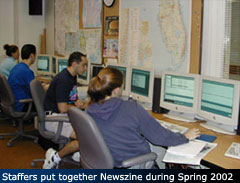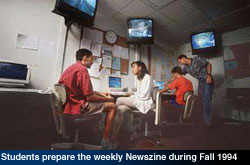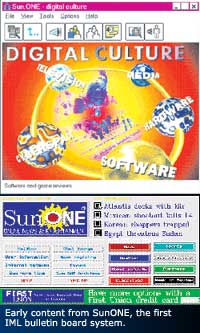Our history

The University of Florida and its College of Journalism and Communications have been involved in electronic publishing projects since the early 1980s. The college, under the leadership of Dean Ralph L. Lowenstein, was the site of the Electronic Text Center. From 1982 to 1985, the Electronic Text Center provided a news and information service, Gainesville Cable Press, on the Cox Cable television system in Gainesville and the surrounding area.
Gainesville Cable Press was a teletext service that was staffed by students and updated 18 hours a day. Its pages, rather like a Rolodex, appeared on television screens throughout the Gainesville area. When teletext proved less than popular with television viewing audiences, the project was closed in 1985. Dean Lowenstein, however, never lost the vision and continued to apply for grants and other funding to continue the research. He struck paydirt in 1993 when a grant from the Freedom Forum enabled the college to hire a visiting professional for the 1993-94 academic year. David Carlson, founding editor of The Electronic Trib at The Albuquerque (N.M.) Tribune, was selected to teach about interactive media as Freedom Forum Professional in Residence.
Development of the Interactive Media Lab began in the summer of 1994. The college made space available in the Flanagan Wing of Weimer Hall, the building that houses all college facilities, including over 400 networked computers and five broadcast stations. The college bought eight 486-class, networked computers to open the lab on the third floor of the building.
Meanwhile, Lowenstein continued his efforts to develop an interactive media program in the college and successfully convinced the University of Florida to hire a faculty member to develop the lab and to teach courses in electronic publishing. After a national search, Carlson accepted the director's post in the fall of 1994.

The lab's first major activity took place in the fall of 1993, even before there was an Interactive Media Lab. Carlson and a master's student, Gary Ritzenthaler, launched what they believe to have been the first journalism site anywhere on the World Wide Web soon after the release of the Mosaic beta in October, 1993.
Development and innovation have continued. The lab now has more powerful computers, video and audio editing equipment, television monitors and wire services from The Associated Press, Reuters, New York Times News Service and Scripps Howard News Service. Students produce a weekly Web newsmagazine called Newszine.
Past projects have included a major partnership to create an early prototype for interactive online services to be offered by community newspapers. It was conceived in late 1994 when the College of Journalism and Communications and the Gainesville Sun agreed to a three-year cooperative effort to produce a commercial interactive newspaper product in Gainesville. The Sun, a New York Times Regional Newspaper Group member, agreed through its parent company to fund research to a create a prototype that could be applicable anywhere in the U.S. and would be affordable for smaller newspapers.

This charge led to development of a stand-alone bulletin board system (BBS) called Sun.ONE. Sun.ONE provided traditional newspaper services including news, sports, features and advertising (both classified and display). It also provided online services such as E-mail, teleconferencing and full Internet access. The original BBS system evolved to encompass other projects as well, including various sites on the World Wide Web. We now participate with The Gainesville Sun in a daily news Web site, Gainesvillesun.com, and we produce a weekly newsmagazine for the Web called Newszine.
Over the years since its founding, the lab and its students have created numerous Web sites for University of Florida entities and non-profit corporations around Florida. IML staff and students also have developed CD-ROMs and interactive DVDs, set up Web cameras, created immersive, 360-degree photos and developed the News Wall for the College of Journalism and Communications.